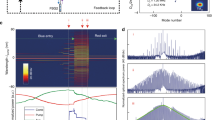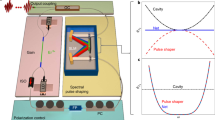Abstract
We demonstrate two-stage laser stabilization based on a combination of Fabry–Pérot and spectral-hole burning techniques. The laser is first pre-stabilized by the Fabry–Pérot cavity to a fractional-frequency stability of σy(τ) < 1 × 10−13. A pattern of multiple spectral holes written in the absorption spectrum of Eu3+:Y2SiO5 serves to further stabilize the laser to σy(τ) ≤ 6 × 10−16 for 2 s ≤ τ ≤ 8 s. We also measure the frequency sensitivity of Eu3+:Y2SiO5 spectral holes to environmental perturbations including temperature (16 kHz K−2), pressure (211.4 Hz Pa−1) and acceleration (7 × 10−12 g−1). Each spectral hole sensitivity parameter is lower than the corresponding parameter for Fabry–Pérot cavities, suggesting that spectral holes can be more frequency-stable.
This is a preview of subscription content, access via your institution
Access options
Subscribe to this journal
Receive 12 print issues and online access
$209.00 per year
only $17.42 per issue
Buy this article
- Purchase on Springer Link
- Instant access to full article PDF
Prices may be subject to local taxes which are calculated during checkout




Similar content being viewed by others
References
Rosenband, T. et al. Frequency ratio of Al+ and Hg+ single-ion optical clocks; metrology at the 17th decimal place. Science 28, 1808–1812 (2008).
Blatt, S. et al. New limits on coupling of fundamental constants to gravity using 87Sr optical lattice clocks. Phys. Rev. Lett. 100, 140801 (2008).
Chou, C. W., Hume, D. B., Rosenband, T. & Wineland, D. J. Optical clocks and relativity. Science 329, 1630–1633 (2010).
Bartels, A. et al. Femtosecond-laser-based synthesis of ultrastable microwave signals from optical frequency references. Opt. Lett. 30, 667–669 (2005).
Zhang, W. et al. Sub-100 attoseconds stability optics-to-microwave synchronization. Appl. Phys. Lett. 96, 211105 (2010).
Fortier, T. M. et al. Generation of ultrastable microwaves via optical frequency division. Nature Photon. 5, 425–429 (2011).
Drever, R. W. P. et al. Laser phase and frequency stabilization using an optical resonator. Appl. Phys. B 31, 97–105 (1983).
Young, B. C., Cruz, F. C., Itano, W. M. & Bergquist, J. C. Visible lasers with subhertz linewidths. Phys. Rev. Lett. 82, 3799–3802 (1999).
Jiang, Y. Y. et al. Making optical atomic clocks more stable with 10−16-level laser stabilization. Nature Photon. 5, 158–161 (2011).
Notcutt, M., Ma, L. S., Ye, J. & Hall, J. L. Simple and compact 1-Hz laser system via an improved mounting configuration of a reference cavity. Opt. Lett. 30, 1815–1817 (2005).
Nazarova, T., Riehle, F. & Sterr, U. Vibration-insensitive reference cavity for an ultra-narrow-linewidth laser. Appl. Phys. B 83, 531–536 (2006).
Webster, S. A., Oxborrow, M. & Gill, P. Vibration insensitive optical cavity. Phys. Rev. A 75, 011801 (2007).
Millo, J. et al. Ultrastable lasers based on vibration insensitive cavities. Phys. Rev. A 79, 053829 (2009).
Thorpe, M. J., Leibrandt, D. R., Fortier, T. M. & Rosenband, T. Measurement and real-time cancellation of vibration-induced phase noise in a cavity-stabilized laser. Opt. Express. 18, 18744–18751 (2010).
Numata, K., Kemery, A. & Camp, J. Thermal-noise limit in the frequency stabilization of lasers with rigid cavities. Phys. Rev. Lett. 93, 250602 (2004).
Notcutt, M. et al. Contribution of thermal noise to frequency stability of rigid optical cavity via hertz-linewidth lasers. Phys. Rev. A 73, 031804 (2006).
Sellin, P. B., Strickland, N. M., Carlsten, J. L. & Cone, R. L. Programmable frequency reference for subkilohertz laser stabilization by use of persistent spectral hole burning. Opt. Lett. 24, 1038–1040 (1999).
Strickland, N. M., Sellin, P. B., Sun, Y., Carlsten, J. L. & Cone, R. L. Laser frequency stabilization using regenerative spectral hole burning. Phys. Rev. B 62, 1473–1476 (2000).
Böttger, T., Pryde, G. J. & Cone, R. L. Programmable laser frequency stabilization at 1523 nm by use of persistent spectral hole burning. Opt. Lett. 28, 200–202 (2003).
Julsgaard, B., Walther, A., Kröll, S. & Rippe, L. Understanding laser stabilization using spectral hole burning. Opt. Express 15, 11444–11465 (2007).
Shelby, R. M. & Macfarlane, R. M. Measurement of the anomalous nuclear magnetic moment of trivalent europium. Phys. Rev. Lett. 47, 1172–1175 (1981).
Yano, R., Mitsunaga, M. & Uesugi, N. Ultralong optical dephasing time in Eu3+:Y2SiO5 . Opt. Lett. 16, 1884–1886 (1991).
Equall, R. W., Sun, Y., Cone, R. L. & Macfarlane, R. M. Ultraslow optical dephasing in Eu3+:Y2SiO5 . Phys. Rev. Lett. 72, 2179–2182 (1994).
Stoneham, A. M. Shapes of inhomogeneously broadened resonance lines in solids. Rev. Mod. Phys. 41, 82–108 (1994).
Könz, F. et al. Temperature and concentration dependence of optical dephasing, spectral-hole lifetime, and anisotropic absorption in Eu3+:Y2SiO5 . Phys. Rev. B 68, 085109 (2003).
Sellars, M. J., Fraval, E. & Longdell, J. J. Investigation of static electric dipole-dipole coupling induced optical inhomogeneous broadening in Eu3+:Y2SiO5 . J. Lumin. 107, 150–154 (2004).
ULE® Corning Code 7972 Ultra Low Expansion Glass, available at http://www.corning.com/docs/specialtymaterials/pisheets/ulebro91106.pdf.
Bergquist, J. C., Itano, W. M. & Wineland, D. J. in International School of Physics ‘Enrico Fermi’ (eds Hänsch, T. W. & Inguscio, M) (North-Holland, 1994).
Leibrandt, D. R. et al. Spherical reference cavities for frequency stabilization of lasers in non-laboratory environments. Opt. Express 19, 3471–3482 (2011).
Chou, C. W., Hume, D. B., Koelemeij, J. C. J., Wineland, D. J. & Rosenband, T. Frequency comparison of two high-accuracy Al+ optical clocks. Phys. Rev. Lett. 104, 070802 (2010).
Dick, G. J. Local oscillator induced instabilities in trapped ion frequency standards. Proceedings of the Precise Time and Time Interval Meeting 133–147 (1987).
Peik, E. & Tamm, Chr. Nuclear laser spectroscopy of the 3.5 eV transition in Th-229. Europhys. Lett. 61, 181–186 (2003).
Rellergert, W. G. et al. Constraining the evolution of the fundamental constants with a solid-state optical frequency reference based on the 229Th nucleus. Phys. Rev. Lett. 104, 200802 (2010).
Heinert, D. et al. Potential mechanical loss mechanisms in bulk materials for future gravitational wave detectors. J. Phys. Conf. Ser. 228, 012032 (2010).
Acknowledgements
M.J.T. acknowledges support from the National Research Council. The authors thank R.L. Cone, J.C. Bergquist, J. Ye, J.L. Hall and D.J. Wineland for useful discussions, and D.R. Leibrandt and J.A. Sherman for help with manuscript preparation. This work is supported by the Defence Advanced Research Projects Agency and the Office of Naval Research and is not subject to US copyright.
Author information
Authors and Affiliations
Contributions
M.J.T., T.R. and L.R. designed the experiments. M.J.T., T.M.F. and M.S.K. performed the experiments. M.J.T. and T.R. conducted the data analysis. M.J.T., T.R., L.R. and M.S.K. wrote the manuscript.
Corresponding author
Ethics declarations
Competing interests
The authors declare no competing financial interests.
Rights and permissions
About this article
Cite this article
Thorpe, M., Rippe, L., Fortier, T. et al. Frequency stabilization to 6 × 10−16 via spectral-hole burning. Nature Photon 5, 688–693 (2011). https://doi.org/10.1038/nphoton.2011.215
Received:
Accepted:
Published:
Issue Date:
DOI: https://doi.org/10.1038/nphoton.2011.215
This article is cited by
-
Noise-characterization photo-receiver designs for mode-locked 100-MHz Ti:Sapphire lasers
Optical and Quantum Electronics (2021)
-
Semiconductor laser active frequency stabilization technologies: a review
Journal of the Korean Physical Society (2021)
-
Exploring gravity with the MIGA large scale atom interferometer
Scientific Reports (2018)
-
Chasing the thermodynamical noise limit in whispering-gallery-mode resonators for ultrastable laser frequency stabilization
Nature Communications (2017)
-
Integrated Pound−Drever−Hall laser stabilization system in silicon
Nature Communications (2017)



